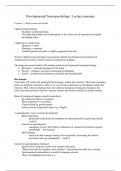Developmental Neuropsychology | Lecture summary
Lecture 1 | Biopsychosocial model
Child neuropsychology
- Paediatric neuropsychology
- The study brain-behaviour relationships in the context of an immature but rapidly
developing brain.
Child brain vs adult brain:
- Dynamic vs static
- Maturing vs matured
- Undifferentiated networks vs tightly organized networks
To form child neuropsychological assessment, add the psychological assessment and
interpretation in terms of brain structure and function together.
The biopsychosocial model is the leading model in developmental neuropsychology.
1. Bio/neuro = neurodevelopment of the brain
2. Psycho = cognitive and socio-emotional development
3. Social = environmental influences (familial and extrafamilial)
Bio domain
First (until ±38 weeks) the prenatal brain develops, mainly the structure. This is the emerging
brain, the hardware formation. Then (±21 y/o), the post-natal brain is developed, mainly the
function. This is the developing brain, the software formation. During development, the
cortex develops posterior (back) to anterior (front), and lateral (outside) to medial (inside).
Brain development happens mostly hierarchical
- Development follows a sequence
- Brain maturation is non-linear
- Characterised by growth-spurts
- In line with developmental stages (e.g. Piaget)
3 contemporary views on brain development
- Brain maturation
- genetically determined development of neuroanatomical regions (prenatally
week 2)
- Interactive specialisation
- emergence of new skill reflects refinement of connectivity between regions
(postnatally – this lecture)
- Skill learning
- brain activation changes during skill acquisition, increasing focal brain
activation with age (postnatally – week 3)
Interactive specialization explained
- Specific brain areas are involved in complex functions
- “Brain areas that fire together, wire together”; specialised networks are evolving
- Environmental stimulation is crucial for shaping networks
- Many (overlapping) networks, e.g.:
, o Social information processing (face network)
o Language (left hemisphere specialisation)
o Reading
o Executive functions
Consequences of injury compared to adults
- Early disruption can have irreversible consequences
- More diffuse pathology affecting the whole brain
- Generalized disturbances in information processing, executive function, social
cognition
- Normal acute recovery, but worse long-term recovery
- Prognosis is more difficult to predict
Growing into deficits
- Progressively emerging cognitive deficits, after early brain injury (congenital /
traumatic)
- Fail to acquire age-expected skills; slowing of cognitive development
- NOT: deterioration or progressive neurologic condition
Psycho domain
- Piagetian stages
- Children need to pass through pre-set developmental stages
- Hierarchical – each stage must be passed
- You cannot force them through
Psychological development is an iterative process
- Neural maturation
- Cognitive skills
- Interaction with environment
Socio domain
- Family unit:
o Language
o Cognitive skills
o Social behaviour
o Rules
- Extra familial contexts
o Academic skills (school)
o Motoric skills (sports, games)
o Identity development (peers)
Healthy nurturing relationships
- Regulation of physiology
- Hunger, sickness, sleep, body temperature, physical contact
- Self-regulation / cognition adequate exposure to language, interactive play, emotional
feedback
Adequate nurturing can be deprived…
- Chronic illness and/or hospitalization
- Parental mental illness (depressed or distressed)
, - Combination of factors
o Low SES
o Multiple family stresses
o Low levels of maternal education
o Previous psychological disturbance
Goals of (child) NP assessment
1. Do cognitive assessment to determine integrity of the brain
2. Detect or diagnose symptoms, syndromes and disorders
3. Characterize strengths and weaknesses in cognition and function
4. Guide towards appropriate rehabilitation, intervention or support… based on NP
profile
5. Monitor outcomes and evaluate interventions/treatments
Depends on setting: acute medical setting vs secondary care (school, outpatient clinic,
rehabilitation unit)
There are 4 important principles:
1. Longitudinal follow-up is crucial
a. As a clinician it is crucial to know the timeline of the child – a longitudinal
perspective
i. Age at time of lesion
ii. Generally greater long-term impact with younger age
iii. Sensitive periods, e.g. language development
iv. Age at testing
v. Recovery vs. development
vi. Time since insult
vii. Greater functional impairment with time
b. Do a careful selection of test for retesting at the follow-up (preferably the same
test). Also state how long the test results will remain valid for.
2. IQ-testing is the foundation (but simplistic)
a. Starting point
b. Global cognitive abilities (simplistic)
c. Sensitive to early brain damage
d. Framework for further hypothesis testing
e. The Cattel-Horn-Carroll model (CHC-model) is the most used one. It has G on
Stratum I (general factor), then it has broad factors on Stratum II (e.g., fluid
reasoning, comprehension knowledge, etc.). On Stratum II are subtests and
narrow factors.
f. IQ <75 is worrisome.
g. Beware of measurement errors (unmotivated child/ bad day/ tired, disobedient,
having a hovering parent, motor restlessness, test anxiety or imprecise
scoring).
3. Age-appropriate testing (and norms)
a. Norms are important because there are differences between generations (e.g.,
WISC-III has a drawing of an old-school home phone that requires one to point
out what it missing, but these phones don’t get used anymore today).
4. Testing lower levels of function first
a. Beyong IQ testing is:
i. Attention
ii. Memory and Learning





